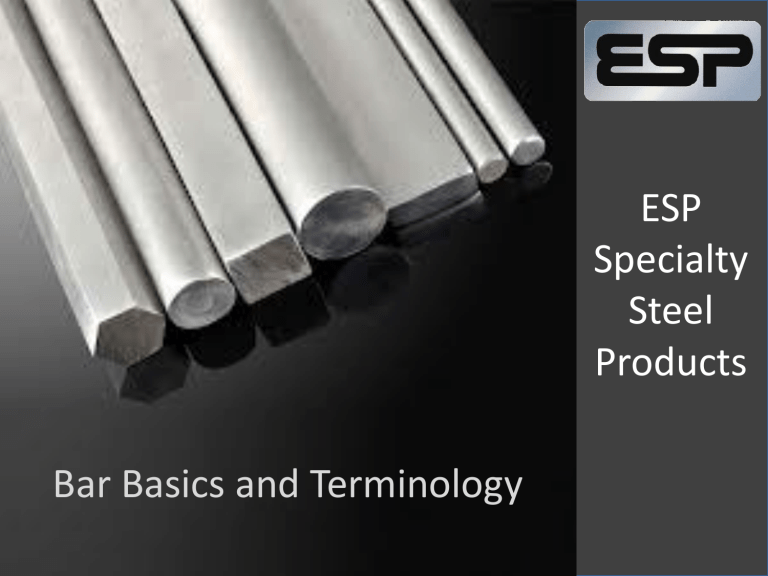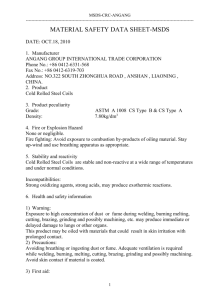Bar Basics and Terminology - ESP Specialty Steel Products

Bar Basics and Terminology
ESP
Specialty
Steel
Products
Bar Terminology
• Long Products
Category of stainless steel that includes rods, bars, and structural products that are described as long rather than flat.
• Bars
Stainless steel formed into long shapes from billets.
They can be rounds, squares, hexagons, octagons or flats, either hot or cold finished.
• Finish
The final condition of the surface after the last phase of production.
2
Bar Terminology
• Hot Rolled
Hot rolling is a mill process which involves rolling the steel at a high temperature (typically at a temperature over
1700° F). When steel is above this temperature, it can be shaped and formed easily, and the steel can be made in much larger sizes. Hot rolled steel is typically cheaper than cold rolled steel due to the fact that cold rolled has additional manufacturing steps in the process. In addition to these extra steps it must also be reheated.
3
Bar Terminology
• Cold Rolled
Cold rolled steel is essentially hot rolled steel that has had further processing. The steel is processed further in cold reduction mills, where the material is cooled (at room temperature) followed by annealing and/or tempers rolling.
This process will produce steel with closer dimensional tolerances and a wider range of surface finishes. The term
Cold Rolled is mistakenly used on all products, when actually the product name refers to the rolling of flat rolled sheet and coil products.
When referring to bar products, the term used is “Cold Finished”.
4
Bar Terminology
• Drawing (Drawn)
A forming process that presses metal into or through a die
(as in cold drawn wire). In this process, the material being drawn is at room temperature (i.e. Cold-Drawn). The pointed/reduced end of the bar or coil, which is smaller than the die opening, is passed through the die where it enters a gripping device of the drawing machine. The drawing machine pulls or draws the remaining unreduced section of the bar or coil through the die. The die reduces the cross section of the original bar or coil, shapes the profile of the product and increases the length and strength of the original product.
5
Bar Terminology
• Annealing: This is a thermal treatment generally used to soften the material being drawn, to modify the microstructure, the mechanical properties and the machining characteristics of the steel and/or to remove internal stresses in the product. Depending on the desired characteristics of the finished product, annealing may be used before, during
(between passes) or after the cold drawing operation, depending on material requirements
• Forging
Forming a hot or cold metal into a fixed shape by hammering or pressing.
6
Bar Terminology
• Bar Peeling
Bar peeling specifically is a machining process used to take a raw forged blank to a polished bar. During the bar peeling process, the forged bars are machined to remove surface cracks, cooled layers of
“skin,” and oxide. It is during the peeling process that the requested dimensions and specifications are achieved on the machined parts, such as: accurate dimensions, surface quality factors, and roundness.
7
Bar Terminology
• Pickling
A process that removes surface scale and oxidation products by immersion in a chemically active solution, such as sulfuric or hydrochloric acid.
• HRAP
Abbreviation for "hot rolled annealed and pickled”
• Grinding
A term that implies metal removal similar to fast milling where the surface is removed by abrasion.
• Centerless Grinding
An operation whereby the surface of a bar is ground without using a lathe
8
Bar Terminology
• Rough Turned Bar – Hot Rolled bar that has been machined to form better shape and remove surface scale.
• Smooth Turned Bar – Further machining (than rough turning) for a smoother, more polished bar that has a tighter tolerance than rough turned bar.
9
10
11
Stainless Applications by Grade
303: Shafts, fittings, screws, nuts, bolts
304/L: Welding, valves, fittings, flanges, shafts
316/L: Marine applications, pumps, shafts, gears, valves, fittings
410: Valves, pumps, knives, fasteners, hand tools
416: Screw machine parts
420: Medical instruments, oil and gas drilling/production
440C:
Pivot pins, valve parts, oil well pumps, knives, surgical & dental equipment
17-4: Aircraft, military, boat shafts, valves, pumps, medical
12
API is the leader in developing equipment, operating standards, and recommended practices for the oil and gas industry.
1.
API-6A - The most popular spec which require certain kinds of performance verification testing on designated wellhead component designs
2.
Within API there are Product Specification Levels (PSL). The higher the PSL number, the more stringent the requirements.
3.
PSL3 - Specification for wellhead and "Christmas tree" equipment (assembly of valves, spools, and fittings).
4.
ESP stocks 3 Oil patch grades of stainless to the API-6A, PSL level3. This is standard in the industry.
5.
Customer specifications - These are customer specific, and are in addition to API's standard specs. Usually they require the producing mill to be on an approved vendor list (AVL), or that the material comes from a DFARS compliant country. Sometimes, a more specific
13 hardness range or yield strength is required on a customer spec.
NACE – National Association of
Corrosion Engineers
NACE created 2 standards that apply to the metals industry
1.
MR0175 - an oil and gas PRODUCTION standard
2.
MR0105 - REFINERY specific standard
NACE determined that tensile strength is a primary factor in SSC -Sulfide Stress
Cracking. But the testing for tensile strength is destructive testing. However, hardness is directly related to tensile strength, and it's testing is non destructive and requires minimal specimen preparation. As a result, NACE has determined an acceptable hardness range for the various grades of metals that is resistant to SSC.
These standards provide a list of acceptable materials, heat treatments, and property requirements for resistance to corrosion and stress cracking in sour gas environments.
Sour gas environments contain wet hydrogen sulfide which occurs naturally in oil, gas, and hot springs, and is very toxic and corrosive.
14
3 Oil Patch Stainless Grades
1.
410 QDT - 410 Quenched and Double Tempered version of the grade 410 has chemistry restrictions. Mainly CR (Chromium). The CR range for 410 QDT is 12.5 to 13.5. In the 410 annealed condition, the CR range is 12 to 13. QDT has been heat treated to 22 RC max and has a 75 or 80 KSI minimum yield, 100 KSI min tensile, and Charpy Impacts (measure of impact strength) are reported.
2.
17-4 HH1150 - Sometimes referred to as H1150D. Aged twice at 1150 degrees
Fahrenheit. NACE has approved grade 17-4 in only 2 conditions for use in the oil and gas industry, HH1150 and H1150M. NACE Maximum Hardness is 33 RC (Note that this is higher than the 22 RC max for most other grades).
3.
420 MODIFIED (420 MOD) - also referred to as 13 Chrome. The chromium content is 12.5 to 13.5. It is a higher carbon version of 410 QDT. When fully hardened, it is the hardest of this family of stainless. It is NACE approved when quenched and double tempered to 18-22 RC hardness range. The minimum yield requirement is 80 KSI
15
16
Illustration of Drawing Process
17
Illustration of Centerless Grinding
18
Illustration of Turning a Bar
19
Steel Making Process
20
Production
Production is the process of extracting petroleum from the underground reservoir and bringing it to the surface to be separated into gases and fluids that can be sold to refineries
21
410 QDT
For parts used in hydrogen sulfide
• Valves, valve components, valve bodies, bonnets, end and outlet connections, fasteners, and valve seat facings
• Bearings
• Bushings
• Pump shafts
17-4 DBH
• Oil field valves
• Shafts
• Pump shafts
• Pump Impeller Shafts
• High strength shafts
• Gears
• Drive components (drive trains) for the drill bit within the drill string (down hole motors)
420 Mod
For parts used in CO2 environments, low hydrogen sulfide levels
• Wellhead equipment (the component at the surface of an oil or gas well that provides the structural and pressure-containing interface for the drilling and production equipment)
• Christmas trees (an assembly of valves, spools and fittings used for an oil and gas well)
• Typically used for completion equipment, structural and pressure containing oil tool parts and members





